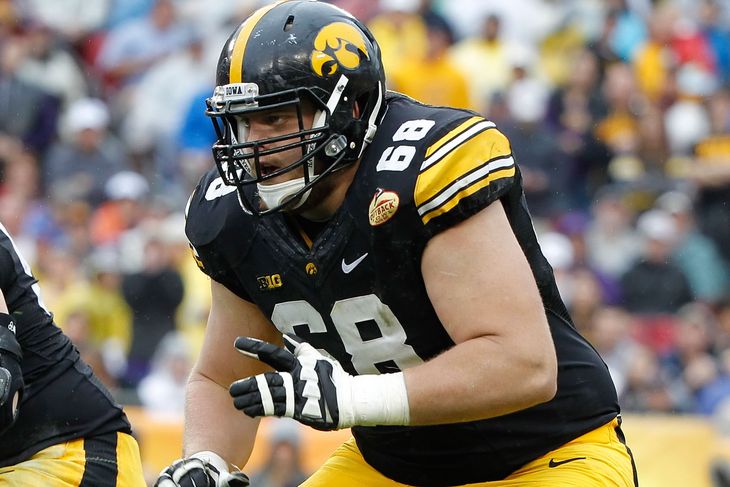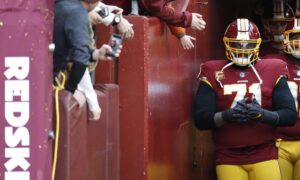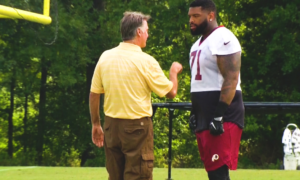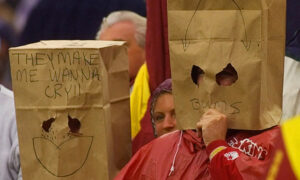The Washington Redskins selected offensive lineman Brandon Scherff with the 5th overall pick in the 2015 NFL Draft. Many were confused with this decision as the top-rated defensive lineman Leonard Williams from USC was still available who’d fill a need in the Redskins New 3-4 Under. Although drafted higher than most predicted, the selection of Scherff definitely has merit as he is a phenomenal run blocker and the top-rated offensive lineman in the draft.
Leading up to the draft general manager Scot McCloughan was quoted in the Washington Post:
“If you want to play in the playoffs, especially in a division like this, you’re going to play in bad weather,” he said moments later. “You’re not going to be able to drop back and throw it 15, 20 times. You’ve got to run the rock, and [larger linemen] usually stay healthier, they’re usually meaner, I don’t know why. But they can get movement up front, so all of a sudden you’re running between the tackles or coming down hill. That’s what you need. And to each their own philosophy, but I’ve had more success with the bigger-bodied guys than smaller.”
After reading this quote and listening to Jay Gruden talk about the changes that would be made to the offensive line this season under recently acquired Bill Callahan from the Cowboys it’s clear that the Redskins want to run more man-power blocking concepts. Under former head coach Mike Shanahan and current head coach Jay Gruden the Redskins favored smaller offensive lineman to set up outside zone-blocking runs and stretch plays while using the bootleg off of play-action in the passing game. In Gruden’s newly installed system, however, it features more standard quarterback dropbacks and the current Redskins offensive line is not adequate to handle the pressure allowing the second largest total sacks in the NFL last season (58) and the third largest total of quarterback hits (113).
Film Study
Let’s take a look at some of Scherff’s plays to see how the 2014 Outland Trophy winner (the award given to the top interior lineman) and Unanimous All-American translates to the NFL.
Run Blocking
Iowa runs many zone-blocking concepts where they pull their tackles across the formation on stretch running plays, but they also run many inside zone runs too. In this play from the Singleback Ace formation, Iowa runs inside zone left with a “King Read” protection. On this protection call, the playside tight end and playside offensive tackle combination block the defensive lineman while reading the playside outside linebacker. Once the linebacker commits to his gap responsibility the corresponding blocker releases from the combination block and takes on the second-level linebacker. In this play, Scherff is the inside blocker of the King Read protection, and he releases to block the playside outside linebacker. This is a very common play/protection you will see from teams that run inside zone running concepts.
Here are two quick plays combined together in one GIF showing Scherff’s run-blocking prowess. In these two plays, Scherff shows his athleticism and finishing ability. Combine these with a mean streak and you have the makings of a road-grade mauler.
Very impressive overall.
Pass Blocking
In pass blocking, Scherff anchors very well against power rushers or players that don’t have extraordinary speed or have developed lateral moves.
Scherff seems to have issues with speed around the edge as kick-steps too far outwards which makse him very susceptible to inside pass rushing moves. Here is a good example of Scherff stonewalling a Nebraskan outside linebacker. In this play, Scherff turns his body 90 degrees right off of the line of scrimmage opening the door to the pass rush. If the quarterback didn’t release the ball so quickly it probably would have resulted in a sack or a quarterback hit at the very least.
Mark Bullock from the Washington Post in his pre-draft study did point out that Scherff struggled with tackle-end-exchanges (TEX) stunts which will certainly be used against him in the NFL where there are more talented pass rushers as seen in this play below.
Here is one last play illustrating Scherff’s inability to adjust to speed rushers. Granted Scherff gets partially tripped by the runningback, but the edge rusher already had Scherff completely turned 90 degrees to get to that point which is just awful positioning. This play does get better however as the Hawkeyes break out the old hook-and-lateral… Watch as Scherff shows his athleticism with the ball!
Where Does Scherff Fit in the Redskins Offensive Line?
I wanted to see what type of running plays the Cowboys ran in their man-power/inside zone running scheme with Bill Callahan to verify Scherff fits into that play-style as well as we might see those in Washington.
Here are two running plays that the Cowboys ran frequently last year. First is a man-on-man blocking concept where each offensive lineman is responsible for their pre-assigned defender. The playside offensive lineman drive block their defenders, while the backside lineman cutoff block their defenders and engage them downfield. This type of play is where Scherff’s athleticism on the backside and his strength in run-blocking would be excellent.
The second play is your inside zone trap from shotgun. The backside guard releases from his position and pulls across the formation, while the center blocks in his place cutting off any penetration into the backfield through the opening hole left by the right guard.
These type of plays are examples of what Bill Callahan will bring to the Redskins. Scherff definitely has the run-mauling ability to play these concepts well. Based on my film study on Scherff above I think he is most suited to play guard in the NFL, but due to the position that the Redskins drafted him (#5 overall) it makes you think that Bill Callahan thinks Scherff can play right tackle opposite of 3x Pro Bowler Trent Williams.
Let’s take a closer look at the Redskins current offensive line to see if it makes sense:
LT: Trent Williams (6’5″ 337 lbs), Xavier Nixon (6’6″ 330 lbs)
LG: Shawn Lauvao (6’3″ 315 lbs), Josh LeRibeus (6’2″ 315 lbs)
C: Kory Lichtensteiger (6’2″ 296 lbs), Chris Chester (6’3″ 303 lbs)
RG: Chris Chester (6’3″ 303 lbs), Spencer Long (6’5″ 311 lbs)
RT: Tom Compton (6’5″ 308 lbs), Morgan Moses (6’6″ 322 lbs)
According to the Washington Post, general manager Scot McCloughan mentioned that he has both right guard and right tackle as areas of need on the offensive side of the ball.
Looking at the roster above, Tom Compton was the biggest sieve by far at right tackle, while 2014-3rd round rookie Morgan Moses is seen as a developmental player and injuries ruined most of his chances to start in the 2015 season. At right guard, Chris Chester actually performed well last year in pass protection, but struggled in run blocking. He is also 32 years old and 2014-3rd round pick Spencer Long should be competing for his position next season anyways. An interesting adjustment to the offensive line could be made where the Redskins could start Chester at center if Callahan thinks Lichtensteiger is not large enough to handle man-power concepts. This would then open the door for Spencer Long to start at right guard or for Brandon Scherff to start in Chester’s place while still looking for a right tackle replacement in the second round.
I believe that based on Scherff’s skill-set and how he compares favorably to former Iowa right tackle Riley Reiff that the Redskins will test him at right tackle to start his career and this was confirmed by Jay Gruden shortly after the first round was over:
“That’s the exciting thing about Brandon is he’s very versatile. Heck, he could even play center if he wanted to,” the coach gushed. “But I think Day 1, we start him out at right tackle. Obviously, we have a Pro Bowl left tackle, and we’ll start [Scherff] out at right tackle, see how he does, and I’m sure he’ll pick it up quickly. The thing we like about him also is he’s a very smart guy. Loves football, studies the game, knows a lot about it, well coached in college, has a lot of experience playing the position, and so I think the transition will be smooth for him.” – Washington Post
In the film study above we looked at how speed rushers gave Scherff a difficult time as he opens the door too easily which might not make his transition as an NFL tackle the easiest. He needs to keep his feet moving and adjust for them around the edge to keep his shoulders more square to the line of scrimmage to better utilize his strength. In the run game his skill set and versatility should instantly transfer to the NFL as a road-grading right tackle.
Overall, I think it was a good selection by the Redskins, but it was certainly surprising nonetheless. Think of it this way: Worst case scenario he follows the same career arc as Robert Gallery – former #2 overall selection by the Oakland Raiders in the 2002 NFL Draft. Gallery was awful playing at left tackle, but still had a long, and successful career with the Raiders at left guard instead.
Follow Samuel Gold on Twitter: @SamuelRGold. For all of Samuel’s articles: Click Here.
Comments
Powered by Facebook Comments
























